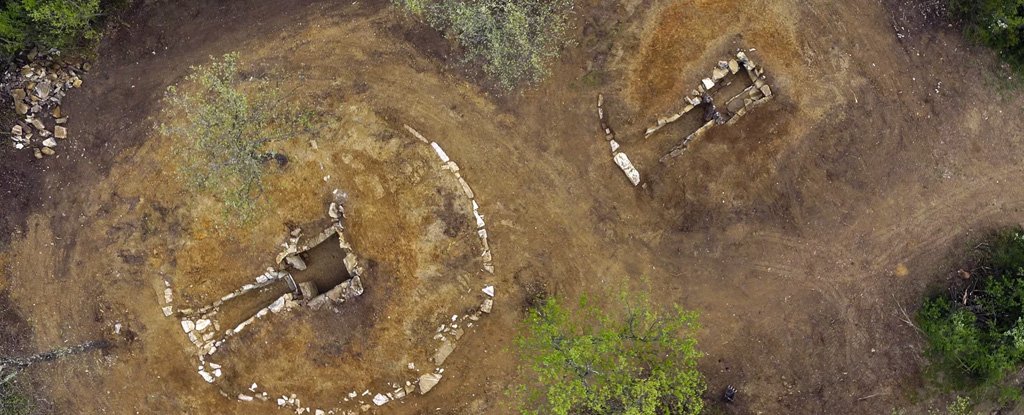Products You May Like
DNA evidence has finally ended the debate about where the ancient Etruscans – an ancient civilization whose remains are found in Italy – came from.
According to almost 2,000 years worth of genomic data, collected from 12 sites across Italy, these enigmatic people did not emigrate from Anatolia (a region that’s now part of Turkey), but shared genetic heritage with people who lived nearby in ancient Rome.
All were descended from pastoralists who moved into the region from the steppes during the Late Neolithic and Bronze Age. Given that the steppes are thought to be where Indo-European languages originated, the finding underscores another Etruscan mystery – that of their (now extinct) non-Indo-European language, which managed to persist for centuries.
“This linguistic persistence, combined with a genetic turnover, challenges simple assumptions that genes equal languages,” said anthropologist David Caramelli of the University of Florence in Italy, “and suggests a more complex scenario that may have involved the assimilation of early Italic speakers by the Etruscan speech community, possibly during a prolonged period of admixture over the second millennium BCE.”
There’s a lot we don’t know about the Etruscans. Some evidence of their presence remains, obviously. We know they were remarkable craftspeople, skilled metalworkers, and politically sophisticated. But we only partially understand their extinct language, which has made teasing out their origins complicated, particularly in the absence of solid genetic evidence.
One school of thought, championed by Greek historian Herodotus, was that the Etruscans migrated into Italy from Anatolia or the Aegean, and that their culture was descended from Greek origins. This interpretation is not favored by modern scholars; archeologists have uncovered very little evidence in support of migration.
The other option is that the Etruscan civilization emerged from an indigenous population that had already been settled in the region – what is known as an autochthonous civilization.
Led by anthropologist Cosimo Posth of the University of Tübingen in Germany, a large international team of researchers sought to get to the bottom of the mystery by studying ancient DNA. They collected genetic samples from 82 individuals spanning a timeframe from 800 BCE to 1000 CE across Etruria and southern Italy, and compared them to DNA from other ancient and modern populations.
They found that the Etruscans shared a genetic profile with neighboring populations, such as the Latins that inhabited Rome at the same time, even though the two groups had significant linguistic and cultural differences.
As with most other European populations, a large proportion of this genetic profile can be attributed to steppe-related ancestry. It’s unclear, then, how such significant differences arose between the Etruscans and their neighbors.
The Etruscan language is not, however, completely unique. It belongs to a proposed group called the Tyrsenian languages, all of which are extinct. This group includes Rhaetic, once spoken in the Alps, and Lemnian, from Lemnos in the Aegean sea.
This could suggest that these languages may have spread via a sea-borne expansion from the Mediterranean, but the genetic profile of the Etruscans shows no evidence of this origin. Instead, the researchers suggest, perhaps the Tyrsenian languages spread from Etruria as a point of origin. Further investigation is definitely warranted.
The team’s analysis also revealed the results of major changes in Italy. When the Roman Empire rose, the ancient DNA revealed, the Etruscan population experienced a significant genetic shift as people from the eastern Mediterranean mixed with the Italian population, likely as the result of the Roman importation of slaves and soldiers.
“This genetic shift clearly depicts the role of the Roman Empire in the large-scale displacement of people in a time of enhanced upward or downward socioeconomic and geographic mobility,” said anthropologist Johannes Krause of the Max Planck Institute for Evolutionary Anthropology, Germany.
In the Middle Ages, following the collapse of the Roman Empire, genetic profiles changed again, with northern European ancestries spreading across the Italian peninsula. This was probably the result of the invasion of the Lombards, from Germany and Sweden, who conquered and then ruled most of Italy from 568 to 774 CE.
From about 1,000 CE, however, the genetic profiles of people in Tuscany, Lazio, and Basilicata have remained more or less unchanged. This is consistent with the genetic profile of people in Rome, the researchers said. Future studies including additional datasets from other regions of the Roman Empire will help substantiate these findings.
“The Roman Empire appears to have left a long-lasting contribution to the genetic profile of southern Europeans, bridging the gap between European and eastern Mediterranean populations on the genetic map of western Eurasia,” Posth said.
The research has been published in Science Advances.
